 Here are some representative examples (see below for details)
Here are some representative examples (see below for details)| Dept of Biology, Lewis and Clark College | Dr Kenneth Clifton
|
|
Biology
221 Lecture Outline
|
Lecture 10: The biology of invertebrates II: lophophorates, molluscs, arthropods, echinoderms and urochordates
Lophophorates
Three diverse invertebrate phyla possess a looped or horseshoe-shaped structure called a lophophore:
The lophophore is used primarily for filter feeding and also for respiration
The phylogeny of this group is fairly controversial because of differences in development (phoronids resemble protostomes). Compare traditional vs. molecular phylogenetic positioning
Bryzoans are small (<1 mm) colonial animals that superficially resemble mosses. Most have a calcified exoskeleton with pores, through which the lophophores extend. Most of the 5,000 spp of bryzoan are marine. The are very common and some are important reef cementer and builders. They also have avicularia, specialized zooids that help keep the colony clean by pinching at settling organisms. Reproduction can be either clonal or sexual.
Brachiopods (lamp shells) superficially resemble clams, although they are divided dorso-ventrally rather than laterally (as in bivalves). The are stalked and typically occur in deep, fine grained benthic habitat. Currently there are only about 300 spp, but 30,000 spp are known from Paleozoic and Mesozoic fossils
Phoronids are tube-dwelling worm-like animals ranging in size from 1 mm to 50 cm. There are only a few (~ 15) species but some can form impressive reef structures.
The Mollusca: how many ways can you use a muscular "foot"?
Molluscs (phylum Mollusca) represent a diverse group of between 100,000 and 200,000 species!
Here are some representative examples (see below for details)
Marine molluscs occur from the intertidal to the abysal depths and range in size from tiny snails to giant clams that weigh 180 kg and squid that stretch almost 20 m and weigh several tons!These include: clams, snails, and cephalopods (octopus and squid)
In addition to filling a variety of niches in many different habitats, molluscs are important to humans for food (though sometimes toxic) and jewelry.
Their fossil shells provide important clues to evolutionary patterns
The simplified organs and neuronal systems are useful for biochemical research.
All molluscs have a basic head-foot body plan but, unlike the annelids, they lack body segments
They have paired gills (ctenidia) that are usually protected by a fold of skin called the mantleThe mantle secretes a calcium carbonate shell that provides protection to most molluscs.
Some molluscs primarily eat algae, while others are pure carnivores. Deep sea species are generally detritivores.
Six Classes of mollusc are important members of the marine community
(Class
Monoplacophora) (Class
Polyplacophora) (Class Bivalvia) (Class Gastropoda) Basic gastropod
anatomy Larval
gastropod Torsion during
development (Class Cephalapoda) Chambered
Nautilis (Class Scaphopoda)
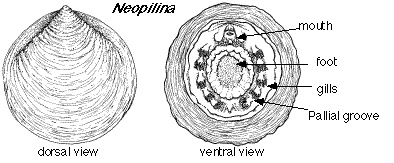
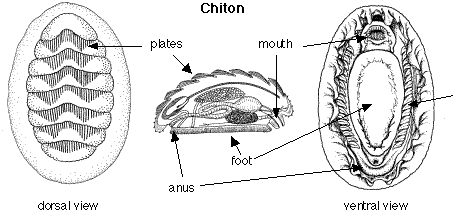

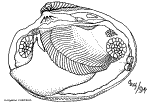
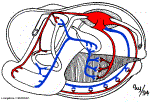

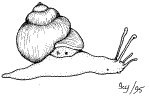


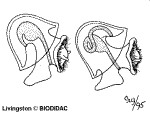
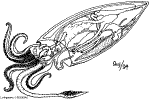
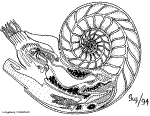
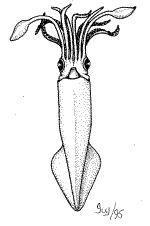
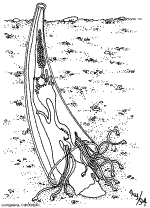
All classes of mollusc except the bivalve possess a chitinous ribbon in the foregut called the radula... this can be modified for many specialized purposesMany molluscs are hermaphrodites, although eggs and sperm often mature at different times.within the same animal.
Bivalves, such as the European oyster show strong patterns of lunar reproductive synchrony corresponding to spring tides.
The life cycle of bivalves includes a trochophore larval stage The jointed invertebrates (phylum Arthropoda)... the planets most successful multicellular organisms
Arthropods are characterized by:
external chitinous skeletonsegmented body
jointed appendages
Marine arthropods belong to one of two sub-phyla: Chelicerata and Crustacea (terrestrial representatives include insects and spiders).
Total living arthropod diversity is estimated at around a billion billion (1018) species!!...
only about 1 million have been described (mostly insects)50,000 are crustaceans.
All arthropods have separate sexes... often transfer sperm via specialized appendages.
Chelicerata
Most marine chelicerates are extinct...
The horseshoe crab (Limulus polyphemus) abounds along the Atlantic and Gulf coasts of the United States.
Limulus are large (to .5 m across) and heavily armored (thick shelled), with to main body sections.
First section: six pairs of appendages, the first are movable claws called chelicerae.
Second section: several pairs of appendages, including highly modified "book gills" that also aid in swimming.
Limulus prey on benthic invertebrates in shallow water.
They form large mating aggregations along the east coast.
Smaller males cling to larger females as the move onshore to lay eggs.
Eggs and larvae represent important food resources for migrating shorebirds.
Crustacea
Crabs, Lobsters and Shrimp:
Decapods (they have five pairs of legs)
Two antennae
Compound eyes (usually on stalks)
A dorsal cover of the cephalothorax called a carapace.
Important member of many marine communities
Most are scavengers (e.g. Cancer, Panularus)
Some herbivores (Loxorhynchus and Mithrax)
Some carnivores (Callinectes)
Females generally hold eggs externally beneath the telson (tail)
Males have evolved elaborate behavioral strategies for attracting and guarding females
Eggs and larvae are generally released on outgoing tides
Barnacles are sessile, shallow water (intertidal) crustaceans that filter feed during periods of immersion.
Echinoderms (Sea stars, brittle stars, sea cucumbers, and sea urchins) Echinoderms are deuterostomes. They, along with chordates (vertebrates) differ from other coelomates (Protostomes) by virtue of their zygote development
Protostomes Deuterostomes Cleavage Spiral and determinate Radial and indeterminate Fate of Blastopore Forms the mouth Usually forms the anus Coelom formation Schizocoelous: Solid masses of mesoderm split to form the coelom Enterocoelous: Outpockets of the gut cavity form the coelom Echinoderms are a diverse (~7000 spp) group of sessile or slow moving marine organisms with secondarily-derived radial symmetry on a pentagonal body plan
They have a water vascular system that permits the motion of extensions called tube feet.
Each tube foot is connected to a bulb like structure called an ampulla (looks and acts like a rubber bulb)Water is exchanged across a dorsal sieve plate called a madreporite.
The outer skin encloses a skeleton of interlocking calcified plates called ossicles.
In urchins and sea stars, Pedicillariae (small specialized ossicles) can pinch to protect against predators and prevent foulingSexes are separate and reproduction sexual, however some echinoderms can regenerate entire bodies from a body fragment.
Six classes within the phylum:
Asteroidea (sea stars) are common carnivores of nearshore habitats. They consume prey by everting their stomachsOphiuroidea (brittle stars and basket stars) have distinct central disks and long flexible arms. Most can move quickly and are voracious carnivores. Most are nocturnal and many use bioluminescence to deter predators. Basket stars eat zooplankton.
Echinoidea (sea urchins and sand dollars) possess a remarkable five-toothed, jaw-like structure called an Aristotle's lantern that is formed from specialized ossicles and ligaments. They are primarily herbivores and their feeding can destroy kelp beds.
Crinoidea (sea lilies) are relatively primitive, cup shaped echinoderms that trap zooplankton with sticky tube feet.
Holothuroidea (sea cucumbers) are relatively soft-bodied when relaxed and can evert their stomach to deter predators.
Concentricycloidea (sea daisies) are recently discovered small animals that live on water logged wood in the deep sea
Urochordates (the sea squirts) Sea squirts are invertebrate members of the phylum Chordata (to which all vertebrates belong)
All chordates possess an embryonic notochord that develops into a dorsal, hollow nerve cord.
They also have, for at least part of their development, a post-anal tail and pharyngeal slits that allow water that enters the mouth to pass back out of the body without entering the digestive tract. This allows for much greater levels of gas exchange and respiration.
Sessile sea squirt or tunicates are usually simple-looking barrel shaped organisms filter water from an incurrent siphon across pharyngeal slits to a body cavity with mucous sheets that trap food particles. All traces of the notochord, nerve cord and tail are lost in the adult form.
Some tunicates can concentrate toxic metals in their skin to deter predation... others can secrete low concentration sulfuric acid.
Planktonic forms (called salps) occur in the open ocean.
A review of some important "moments" in the evolution of multicellular animals 1) The Parazoa/Metazoa Split: No true tissues (sponges) vs. true tissues (all other multicellular animals)
2) The Radiata/Bilaterala Split: Cniderians and Ctenophores vs the rest of the higher inverts
Two distinguishing featuresa) Radial vs Bilateral symmetry (allows cephalization)... careful here...radial symmetry is also a secondarily evolved characteristic (e.g. some echinoderms)b) Dipoblastic (two germ layers) vs. triploblastic (three germ layers)
Radiata (dipoplastic) Bilaterala (triploblastic) Top and bottom Yes Yes Head and rear ends No Yes Left and right No Yes 3) The Acoelomate/Coelomate Split: No body cavity (flatworms) vs. a body cavity
Body cavities allow for a much greater potential for motion as muscles can exert force off of the cavityAll animals with a body cavity have some form of blood vascular system: blood that circulates through a network of spaces or vessels.
Animals with a body cavity not entirely lined by mesoderm (roundworms and ribbon worms) are called pseducoelomates.
4) The Protostome/Deuterostome Split: Mollusks, annelids, and arthropods vs echinoderms and chordates (see above for characteristic differences in zygote development